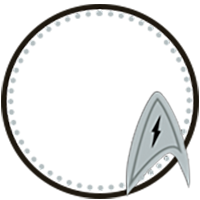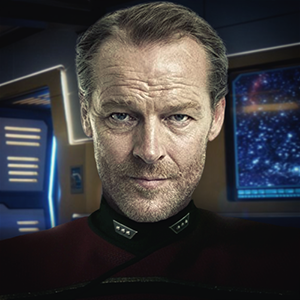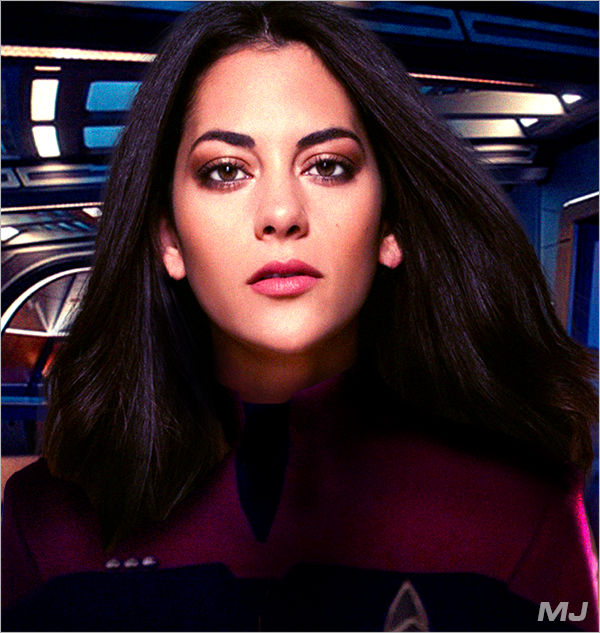Gabrielle Camargo was at this moment the spider at the heart of a growing web, watching all and looking for anything that didn’t fit the definition of ‘normal’. At the captain’s orders, she’d tasked every shuttle, fighter and probe she could to grow her network of sensors across the near-barren star system. Everything save the ship’s old Danube-class runabouts, currently spread across the Badlands doing their own missions, had been launched at her direction.
She’d have preferred to work with T’Val, devise a grid search pattern and have Atlantis herself fly it, bringing her imminently superior sensor arrays to the task, but she could see the logic of wanting to keep the ship near the unresponsive and mysteriously shielded comms relay. Shuttles and fighters weren’t ideal for the task at hand, their onboard computers likely to dismiss certain findings, so much like the probes that had been launched, everyone was relaying their raw sensor reads back to be processed by Atlantis, reviewed by Gabrielle and the astrophysicists she knew where huddled in a lab no doubt arguing over something minuscule.
“Hold up T’Val,” she said as one specific set of readings on her screen caught her attention. “Can you backtrack about five hundred kilometres, please? And point your sensors along zero-four-eight mark zero-one-eight?”
“Affirmative Lieutenant Commander,” came the response from the ship’s Vulcan helmswoman who was currently piloting Harpy 2. Harpy 2, an A/R model Valkyrie-starfighter, had perhaps the single most sophisticated and sensitive sensor setup of any of the ship’s small craft. The only problem was the sensors were incredibly limited in their view, designed for recon work, not generalised science. And more so than any other craft, the starfighter’s onboard computer was a clever idiot, hyper-focused on its designed purpose and woefully incompetent with sophisticated scientific analysis outside its purview. T’Val wasn’t seeing anything that Gabs was, but Atlantis was picking out the oddities from the raw feed.
As shuttles and probes reported oddities, or Atlantis and her people picked them out, T’Val was being tasked to move around and poke Harpy 2’s superior sensors at a problem. It wasn’t ideal, but it allowed the rest of the sensor platforms to keep scanning the system while letting them investigate potentially interesting phenomena in detail.
Potentially interesting phenomena like she was seeing on her screen right now.
“T’Val, I’m sending you some processed data, tell me what you think.” There were six sets of sensor data, nearly all identical, that Harpy 2 had run over now. Each were faint echoes in subspace, very nearly parallel to each other as they cut across the system.
“It would, at first glance, look like some sort of subspace flow to me,” came the Vulcan’s stoic reply. “At first glance. More data would be required to confirm it, however.”
“Agreed. Can you go back and fly the six tracks for say, five minutes? If each is perfectly straight for that length of time I think we can safely assume they’ll be straight to their point of origin, yes? Might hint at what type of anomaly we’re looking at.”
“It is a conclusion,” T’Val responded, not agreeing, but not disagreeing either.
After only fifteen minutes Gabs had decamped from the bridge of Stellar Cartography, having picked up a few of her people on the way to look at the tentative data. Ensign Goresh Krek, the irascible Tellarite who had earned the nickname Starkiller, was manning the main console and working the holographic chamber’s systems with practised ease. Then there was Lieutenant Gerald Wilbur-Northcote, whose practised and aristocratic accent grated on Gabs’ nerves, but whose intellect couldn’t be denied.
“It looks to me,” she said, “like some sort of wormhole.”
“Pah!” Krek spat out. “A layman’s term for any number of phenomena.”
“Goresh, please, the Commander is a generalist, not a specialist like we are.” Gerald’s tone of voice wasn’t quite patronising but bordered on it. “What the Ensign is trying to say is –“
“I understood what the Ensign was saying,” Gabs said, cutting on Gerald. “I also said ‘some sort of’ to encompass the myriad of phenomena.”
Krek huffed, then nodded their head in understanding. “Yes, sorry.” It was gruff, but an apology nonetheless. “But it’s not a wormhole, that the layperson would understand at least.”
Sensor feeds, readouts, analysis and spectrographic displays were brought up as holographic screens in the near-perfect representation of the space around Atlantis, save for a flurry of blue deltas representing each of the shuttles and probes and the three red lines T’Val had confirmed that shot off into infinity.
“This here,” Krek brought one of the screens closer, “is evidence of anti-neutrinos interacting with subspace. But this,” another screen was brought forward, “looks like a transporter signal.”
“Some Dominion ships were equipped with extremely long-range transporter systems. Lightyears in range.” Gerald stroked his chin in thought. “But most ships and facilities were outfitted to prevent that sort of thing from happening once countermeasures were worked out.”
“Wasn’t that just a handful of lightyears though?” Gabs asked, then settled a hand on Krek’s shoulder. “Extrapolate those sensor traces to a convergence point would you Ensign.”
With a sigh of protest, which basically was Krek’s default answer to anything, the deed was done and the holographic chamber whirled around them. No longer was there a small ball of fire in front of them, the representation of the system’s primary, but the whole galaxy now hovered in front of the platform was a disc at a slight angle backwards. The red lines cut across the disc, terminating in the Delta Quadrant some forty-five thousand lightyears away.
Borg space.
“We ran the numbers three times ma’am,” Gabrielle said, with Krek and Gerald at her back as she faced Captain Theodoras and Commander Kendris back on the bridge not ten minutes later. “And then found our answers in the database – a spatial trajector. Voyager encountered one and the after-action reports said one was on the Artifact. A sort of super long-range transporter. The point of origin is in suspected Borg space and it crosses the orbital path of CR-718 multiple times over the last few weeks.”
“They were walking their fire,” Krek blurted out, then huffed when everyone looked at them. “The Borg likely had a decent idea of where the station was, but couldn’t be exact. So they made a few attempts and adjusted each time. The last reading was the most intense, so the others were likely some sort of probe or sensor package they could recover to refine their targeting lock.”
“And stations are far more predictable than starships,” Kendris added. “A few attempts, a few adjustments, then send in something heavier.” She turned in her seat to the captain. “Though could the Borg still have done something like augment a relay station’s shields so intensely?”
“It’s the Borg,” Tikva grumbled. “Assume they can do anything they want and be pleasantly surprised when they can’t.” The captain mused for a moment, fingers tapping on her armrests, eyes focused somewhere in the middle distance before she spoke. “Find me something, anything we can use to block this trajector thing. Whatever is over there has trapped our people, it’s on us to trap it too.”
“Aye ma’am,” Gabrielle answered, then turned to her people. “You heard the captain, let’s go find a way to jam up a Borg transporter.”

 Bravo Fleet
Bravo Fleet










